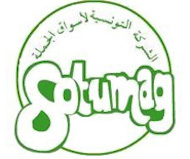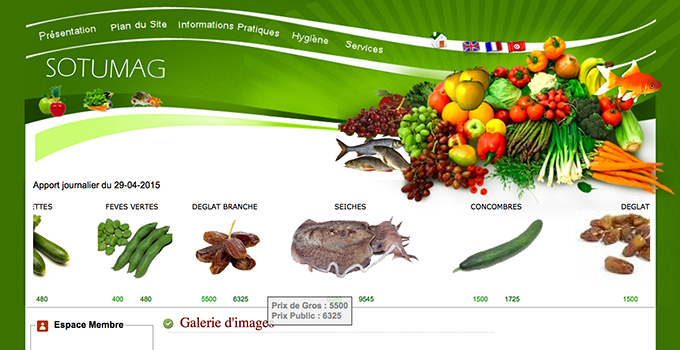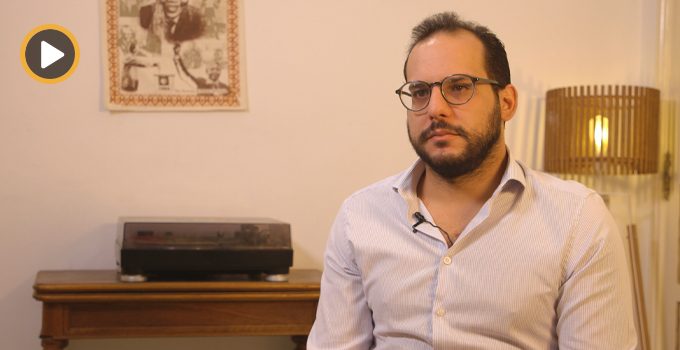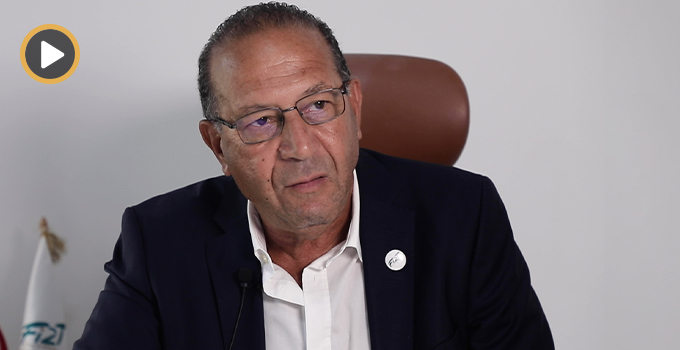
What are the State institutions and policies that govern Tunisia’s food markets? The gamut of actors that propel the distribution of basic commodities throughout the country—growers and producers, transporters, vendors, municipalities, regulatory authorities, consumers—constitutes a vast web which renders daunting the monitoring and measuring of interior commerce. The following is a preliminary examination of the formal, or state-regulated, constituent of this web. Law n°94-86 of 23 July 1994 provides a basic definition of the networks and layers which comprise the country’s distribution circuits of agricultural and seafood products:
The distribution circuits regulated by the present law encompass production markets, wholesale markets, and retail markets of agricultural and seafood products, including mobile points of sale. Also included in distribution circuits are calibration and packaging units and refrigerated storage warehouses for agricultural and seafood products.
Production Markets Any space developed in production zones with the objective to facilitate the collection, standardization, packaging, storing and pricing of agricultural and seafood products. These markets operate seasonally according to the production periods of products sold. Production markets are for the initial wholesale of agricultural and seafood products.
Wholesale Markets Any space developed in consumer areas with the objective to facilitate the sale of agricultural and seafood products and to reinforce the transparency of prices by the standardization, packaging, storing, and competition of products. Wholesale markets are for the wholesale of agricultural and seafood products by producers, production companies, groups of producers, service cooperatives, sellers, buyers, collectors, packagers, wholesale distributors, and importers.
Retail Markets Any space developed in the form of municipal markets, weekly markets, independent or integrated retail outlets ensuring the sale of agricultural and seafood products. The municipal retail market is developed by the municipality within the communal perimeter and composed of spaces reserved for the daily retail sale of agricultural and seafood products. The organization, functioning, and management of the municipal retail market are determined by the municipality via contract specifications.
Definitions adapted and translated from the Official Journal of the Tunisian Republic dated 26 July 1994
While production and wholesale markets are «created by joint order of the Minister of the Interior and the Ministers of Commerce, Agriculture and taking into account the opinion of the Ministers of Public Health, Environment, and Urban Development», municipal markets are organized and managed by local authorities. The overarching State body which coordinates these intermediaries, regulates activities, develops strategies, and oversees efforts to consolidate the circulation of basic commodities throughout the country is the Ministry of Commerce and Handicrafts.
Modernizing and Consolidating Distribution Circuits of Basic Commodities
According to the Ministry’s webpage, the National Program for the Modernization of Distribution Circuits for Agricultural and Seafood Products (PNMNCDPAP) aims to
● upgrade infrastructures to conform with standards for technology, hygiene, and environment,
● improve the monitoring and management of distribution circuits,
● promote product quality within four primary sectors—fruits and vegetables, meats, seafood, and poultry.
Under Prime Minister Mehdi Jomaa, Decree n°2004-1107 of 17 May 2004 creating a management unit to define the objectives of the PNMNCDPAP was amended to modify the duration of the project—1 July 2004 – 30 June 2017—and allow for an extension of up to three years.
Presuming that the most direct way to gather specific information concerning the regulatory framework and bodies of formal distribution circuits, Nawaat contacted several of the institutions that play a part in the national modernization program. In fact we found these key actors reluctant to share much more than what can be found on their websites, and often our requests for interviews or information were answered with referrals to the Ministry of Commerce. We did nonetheless receive some clarification and insight from several individuals within these organisms.
ARRU, Technical Operator
 Our first visit was to the Agency for Urban Rehabilitation and Renovation (ARRU), «a public company of industrial and commercial function» which was created within the Ministry of Equipment by Law n°81-69 of 1 August 1981. «In light of the company’s experience in the domain of public and commercial facilities, the Ministry of Commerce and Handicrafts, the Ministry of the Interior, and the Ministry of Urban Development assigned ARRU the work of updating the basic infrastructure for slaughterhouses, wholesale fruit and vegetable markets, and livestock markets». With an estimated cost of 28.5 million dinars, 58 projects—11 slaughterhouses, 26 wholesale markets, and 21 livestock markets—constitute ARRU’s contribution to the modernization of the country’s distribution circuits. Describing ARRU as technical operator of the national program, a company representative explained1 that equipment and materials are supplied according to the physical state and conditions of markets and distribution sites and in measure with the amount of project funding. In this sense, our interlocutor explained, ARRU’s work within the context of the program «represents a beginning; it is not a complete renovation but an evolving modernization which takes into account financial means available».
Our first visit was to the Agency for Urban Rehabilitation and Renovation (ARRU), «a public company of industrial and commercial function» which was created within the Ministry of Equipment by Law n°81-69 of 1 August 1981. «In light of the company’s experience in the domain of public and commercial facilities, the Ministry of Commerce and Handicrafts, the Ministry of the Interior, and the Ministry of Urban Development assigned ARRU the work of updating the basic infrastructure for slaughterhouses, wholesale fruit and vegetable markets, and livestock markets». With an estimated cost of 28.5 million dinars, 58 projects—11 slaughterhouses, 26 wholesale markets, and 21 livestock markets—constitute ARRU’s contribution to the modernization of the country’s distribution circuits. Describing ARRU as technical operator of the national program, a company representative explained1 that equipment and materials are supplied according to the physical state and conditions of markets and distribution sites and in measure with the amount of project funding. In this sense, our interlocutor explained, ARRU’s work within the context of the program «represents a beginning; it is not a complete renovation but an evolving modernization which takes into account financial means available».
SOTUMAG and Bir el Kassaa
 Though it shares fundamental objectives with and has directly benefited from PNMNCDPAP, the Tunisian Company of Wholesale Markets, or SOTUMAG, was created within the Ministry of Commerce well before PNMNCDPAP was implemented and has a smaller scope of focus. Signed into effect by Habib Bourguiba under Law n°80-68 of 10 November 1980, SOTUMAG is a public limited company whose keystone operation is Bir el Kassaa, the country’s largest wholesale market. Bir el Kassaa, located some ten kilometers south of Tunis, is also the country’s model Market of National Interest (MIN) among whose primary objectives are to consolidate, through conformity with regulatory mechanisms and the monitoring of commercial activities in wholesale markets, the country’s distribution circuits of distribution. «The MIN of Bir el Kassaa operates to shorten distribution circuits through the clarification of transactions and the direct transfer of products to their destination market [and] to integrate all transaction sites for agricultural products into one network».
Though it shares fundamental objectives with and has directly benefited from PNMNCDPAP, the Tunisian Company of Wholesale Markets, or SOTUMAG, was created within the Ministry of Commerce well before PNMNCDPAP was implemented and has a smaller scope of focus. Signed into effect by Habib Bourguiba under Law n°80-68 of 10 November 1980, SOTUMAG is a public limited company whose keystone operation is Bir el Kassaa, the country’s largest wholesale market. Bir el Kassaa, located some ten kilometers south of Tunis, is also the country’s model Market of National Interest (MIN) among whose primary objectives are to consolidate, through conformity with regulatory mechanisms and the monitoring of commercial activities in wholesale markets, the country’s distribution circuits of distribution. «The MIN of Bir el Kassaa operates to shorten distribution circuits through the clarification of transactions and the direct transfer of products to their destination market [and] to integrate all transaction sites for agricultural products into one network».

A unique feature of SOTUMAG’s website is a band of images that runs across its main page indicating the season’s offering of agricultural and seafood products and associated prices—both wholesale and retail—available in the market. An interesting resource for consumers, the list serves as a standard reference for market vendors. Interest piqued by this singularly accessible and up-to-date information regarding consumer goods, Nawaat planned a visit to Bir el Kassaa to observe its day-to-day operations, the unloading of fruits, vegetables, and seafood, the set-up and opening of the market before sunrise, the foot traffic, the transactions of vendors and buyers, the infrastructure … Needless to describe our disappointment, during an initial trip to speak with a company representative, as we were handed the number for the Ministry of Commerce and our imagined market walk was postponed until a formal tour could be approved by the Ministry.
Daily Bulletins and Price Reporting at the Ministry of Commerce
Between his morning tour of municipal markets and afternoon meetings at the office, Communications Manager for the Ministry of Commerce Mohamed Ali Ferchichi invited Nawaat to department headquarters in Tunis. The main points that Ferchichi emphasized2 were transparency, the necessity of having on-site control mechanisms, and the diffusion of up-to-date information. In this vein he described his daily rounds at two or three different markets during which he relays (by phone) to Mosaique FM the current prices of fruits and vegetables at municipal markets; he is also responsible for transmitting the same information to the Minister. In addition to these daily excursions and reports, he checks the daily bulletins diffused within the Ministry by SOTUMAG and the National Observatory of Supply and Prices (ONAP). Sitting in front of his computer, Ferchichi pulled up the bulletins of the day and read off the volume and prices of local potatoes, imported potatoes, tomatoes, peppers, etc. by region.
ONAP – Country-wide Monitoring of Product Prices and Volume
 Whereas SOTUMAG diffuses the standard for prices of products at Bir el Kassaa, ONAP covers the entire territory and all basic commodities for which demand is high.3 Created by Law n°94-86 cited above, ONAP functions to «process and track statistical data and commercial information relating to the production, storage, transformation, distribution, and consumption of these basic commodities with the goal to supply the necessary information with regard for market control in time and space and the reinforcement of the transparency of commercial transactions». The law requires that «establishments, companies, groups, and organisms stocking, transforming, transporting, distributing, or consuming products relative to ONAP’s field of work» supply the information requested by ONAP agents who are in turn to handle the information collected in confidentiality. The Ministry webpage for ONAP elaborates that among its responsibilities are the creation and manipulation of data bases to produce analyses and economic forecasts of supply and demand. The agency is responsible for obtaining information regarding the supply and prices of fruits, vegetables, fish, poultry, meat, eggs in wholesale and municipal markets throughout the country and specifically concerning «the supply of multiple sensitive and strategic products in the district of Tunis through on-site visits by ONAP agents».
Whereas SOTUMAG diffuses the standard for prices of products at Bir el Kassaa, ONAP covers the entire territory and all basic commodities for which demand is high.3 Created by Law n°94-86 cited above, ONAP functions to «process and track statistical data and commercial information relating to the production, storage, transformation, distribution, and consumption of these basic commodities with the goal to supply the necessary information with regard for market control in time and space and the reinforcement of the transparency of commercial transactions». The law requires that «establishments, companies, groups, and organisms stocking, transforming, transporting, distributing, or consuming products relative to ONAP’s field of work» supply the information requested by ONAP agents who are in turn to handle the information collected in confidentiality. The Ministry webpage for ONAP elaborates that among its responsibilities are the creation and manipulation of data bases to produce analyses and economic forecasts of supply and demand. The agency is responsible for obtaining information regarding the supply and prices of fruits, vegetables, fish, poultry, meat, eggs in wholesale and municipal markets throughout the country and specifically concerning «the supply of multiple sensitive and strategic products in the district of Tunis through on-site visits by ONAP agents».
Beyond State Institutions and Policies: The Un-traceability of Informal Commerce
Insight shared by the individuals with whom we spoke at the Ministry of Commerce and affiliated agencies converged on several points and indicated topics which merit further examination.
Whereas these institutions and agencies are engaged in tracking the formal commerce and economy of the country’s distribution circuits, a significant proportion of transactions (of which the precise volume and value remains unquantified) exist outside of this network. According to our interlocutor at ARRU, a slackening of State controls since 2011 has allowed for the growth of this informal commerce while wholesale markets have diminished in terms of the volume of products that pass through and the influx of buyers as many producers have opted to sell on-site and thereby avoid paying transport fees. This has resulted in the multiplication of intermediaries and consequently product prices which have doubled and even tripled by the time they reach the consumer.
To counter this trend, the same ARRU representative explained, the first necessity is a source of consistent and reliable data and statistics which can be applied to develop strategies that respond directly to issues and needs. While SOTUMAG and ONAP provide this for State-regulated distribution circuits, informal commerce remains beyond the scope of government-operated tracking mechanisms. If impossible to measure the precise volume and value of this commerce, it is at least feasible and pertinent to gauge its general scope, advantages for intermediaries and consumers, and role within/impact on the distribution and economy of basic commodities in Tunisia. Finally, further exploration of formal distribution circuits will require the perspective of smaller stakeholders, those working in production, wholesale, and municipal markets throughout the country’s regions. The management and operation of municipal markets will be particularly important to track as the country prepares for the election of local authorities in the coming months.
Notes
1. ARRU representative. Personal interview. 5 May 2015.
2. Mohamed Ali Ferchichi. Personal interview. 6 May 2015.
3. Official at the Ministry of Commerce. Personal interview. 6 May 2015.
The official with whom we spoke emphasized the importance and reliability of the comprehensive information provided by ONAP.




I have some studies and research done by myself in 1997, when i had prepared somes files concerning the export of fish really we have no serious sources in that time.i do not not if some institutions now could be taken siriously i guess yes.
THE IMPORTANCE OF MARKET INFORMATION SYSTEMS
By Boubaker Ben-Belhassen
Director, Trade and Markets Division
United Nations Food and Agriculture Organization (FAO)
Prices are key for making decisions by all agents in the market – producers, consumers, traders, middlemen, commodity boards, governments, etc. That is why timely and credible information on markets, beyond prices, is critical. In fact since the global food price crisis in 2007-08, an increasing interest has emerged in the development of market information systems – systems that provide up-to-date information on production, utilization, trade, stocks and prices. The spikes in international food prices in 2007-08 resulted in higher domestic food prices in the majority of developing countries, which had affected consumption of low-income populations and resulted in food riots and social unrest.
Without quality data and accurate information on markets, decisions can only be second-guessed. Market information systems contribute to improved governance of commodity markets. Against this background, the Food and Agriculture Organization of the United Nations (FAO) has intensified its food market monitoring and analysis activities.
One of the core functions of FAO is to: “Assemble, analyze, monitor and improve access to data and information”. This is a clear reflection to the high priority attached by FAO and its Members to data and information. FAO maintains a comprehensive market intelligence service of the main agricultural commodities, keeps under review global issues that affect trade in agriculture and provides analytical and policy relevant information. More information can be accessed at this URL link: http://www.fao.org/economic/est/trade-and-markets-home/en/
FAO also issues regular reports on commodity market developments. These include Food Outlook (last edition), Crop Prospects and Food Situation (last edition) and the OECD-FAO Agricultural Outlook (2014 edition). The objective of the publications is to inform the international community and policy makers about current market situation and future outlook, while highlighting major emerging issues. Archives of all these reports can be found at the above URL link.
Two tools I would like to mention here: the Global Information and Early Warning System (GIEWS) and the Agricultural Market Information System (AMIS).
GIEWS was established in the wake of the world food crisis of the early 1970s. The system continuously monitors the world supply and demand outlook for basic foods and is the leading source of information on food production and food security for every country in the world. More recently, GIEWS developed the Food Price Monitoring and Analysis Tool, providing easy access to over 1 100 consumer price series in 85 countries around the globe and 43 international cereal export price series. The Price Tool can be linked to existing data collection systems and permits countries to monitor, analyze and disseminate price data for a wide range of commodities in markets of their choice. More information on GIEWS and its products can be accessed here: http://www.fao.org/giews/english/index.htm
The second initiative is the Agricultural Market Information System, known with its acronym as AMIS. Established in 2011 at the request of the G20 Agriculture Ministers, AMIS is an inter-Agency Platform to enhance food market transparency and encourage coordination of policy action in response to market uncertainty. The system covers currently four crops that are of particular importance in international food markets, namely wheat, maize, rice and soybeans. AMIS seeks to strengthen collaboration and dialogue among main producing, exporting and importing countries. Apart from G20 members plus Spain, participants in AMIS include seven major producing, consuming and exporting countries of commodities covered by AMIS. In addition, AMIS reaches out to other key stakeholders in international food markets such as commodity associations and institutional investors in commodity markets.
It is strongly encouraged that countries embark on such initiatives to develop proper market information systems, whether nationally or regionally. This is fundamental to improving governance and decision-making processes.